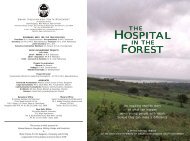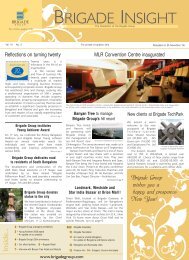a concise field guide to indian insects and arachnids
a concise field guide to indian insects and arachnids
a concise field guide to indian insects and arachnids
Create successful ePaper yourself
Turn your PDF publications into a flip-book with our unique Google optimized e-Paper software.
A CONCISE FIELD GUIDE TO INDIAN INSECTS AND ARACHNIDS<br />
COLEOPTERA<br />
220<br />
221
A CONCISE FIELD GUIDE TO INDIAN INSECTS AND ARACHNIDS<br />
COLEOPTERA<br />
DR J. POORANI<br />
OTHER EXAMPLES IN<br />
SCARABAEIDAE<br />
Order: Coleoptera<br />
Family: Scarabaeidae<br />
SCRUB<br />
RHINOCEROS BEETLE<br />
HEAD: Brownish-black (a single<br />
prominent horn in case of males)<br />
PRONOTUM: Brownish-black, keeled in<br />
both sexes<br />
ELYTRA: Brownish-black<br />
ANTENNA: Clubbed<br />
Oryctes rhinoceros<br />
KARTHIKEYAN S.<br />
FLOWER BEETLES<br />
Clinteria coerulea<br />
KARTHIKEYAN S. DR M. S. MAYILVAHNAN<br />
SIZE: 20 mm<br />
HABITAT: Adults: coconut palm;<br />
Larvae: decaying leaf matter, dung or<br />
compost heaps<br />
OTHER INFORMATION: Major pests<br />
of coconut palm; makes V-shaped<br />
wedges in leaves, reducing yield.<br />
SHINING LEAF CHAFERS<br />
Trigonophorous delesserti (red)<br />
SHINING LEAF CHAFERS<br />
Trigonophorous delesserti (green)<br />
248<br />
249
A CONCISE FIELD GUIDE TO INDIAN INSECTS AND ARACHNIDS<br />
COLEOPTERA<br />
T. N. A. PERUMAL<br />
DR M. S. MAYILVAHNAN<br />
LEAF-ROLLING WEEVIL<br />
Apoderus scutellaris<br />
RED PALM WEEVIL<br />
Rhynchophorus ferrugineus<br />
Order: Coleoptera<br />
Family: Curculionidae<br />
ORNAMENTALS<br />
SCRUB<br />
HEAD: Rust/brown<br />
PRONOTUM: Rust/brown<br />
ELYTRA: Rust/brown<br />
ANTENNA: Thread-like<br />
PRONOTUM: Reddish-orange with dots<br />
HEAD: Elongates in<strong>to</strong> snout bearing<br />
the antennae<br />
ELYTRA: Reddish-orange, but forewing<br />
does not cover the entire abdomen<br />
Order: Coleoptera<br />
Family: Curculionidae<br />
SCRUB<br />
SIZE: 5-8 mm<br />
ANTENNA: Thread-like<br />
HABITAT: Found in leaves <strong>and</strong> stems<br />
of plants. The weevil cuts slits in<strong>to</strong><br />
leaves <strong>and</strong> then lays her eggs. Then<br />
it rolls the leaves around where the<br />
eggs are laid <strong>to</strong> feed <strong>and</strong> protect the<br />
developing larvae<br />
OTHER INFORMATION: Minor agricultural<br />
pest<br />
SIZE: 25 - 30 mm in length<br />
HABITAT: Adults are found in foliage<br />
of palm trees where they lay eggs<br />
at the base of tender leaves. Larvae<br />
consume palm leaves <strong>and</strong> tree tissue,<br />
thereby killing the palm trees<br />
264<br />
265
Red Velvet Mite A CONCISE FIELD GUIDE TO INDIAN INSECTS AND ARACHNIDS<br />
ACARI<br />
CLASS ARACHNIDA<br />
ORDER ACARI<br />
(Mites <strong>and</strong> Ticks)<br />
Mites <strong>and</strong> Ticks are Acari found across the polar regions<br />
<strong>to</strong> sulphur springs; from deep mines <strong>to</strong> fresh water <strong>and</strong><br />
even in seawater. Practically, no biome is Acari-free. After<br />
bacteria, they are the most successful organisms on the<br />
planet. They have adapted for both free-living as well<br />
as parasitic lives. Mites have given up their preda<strong>to</strong>rial<br />
quest <strong>and</strong> tend <strong>to</strong> be plant-feeders or scavengers while<br />
Ticks are preda<strong>to</strong>rs <strong>and</strong> bloodsuckers.<br />
DR M. S. MAYILVAHNAN<br />
500<br />
501
562 563















